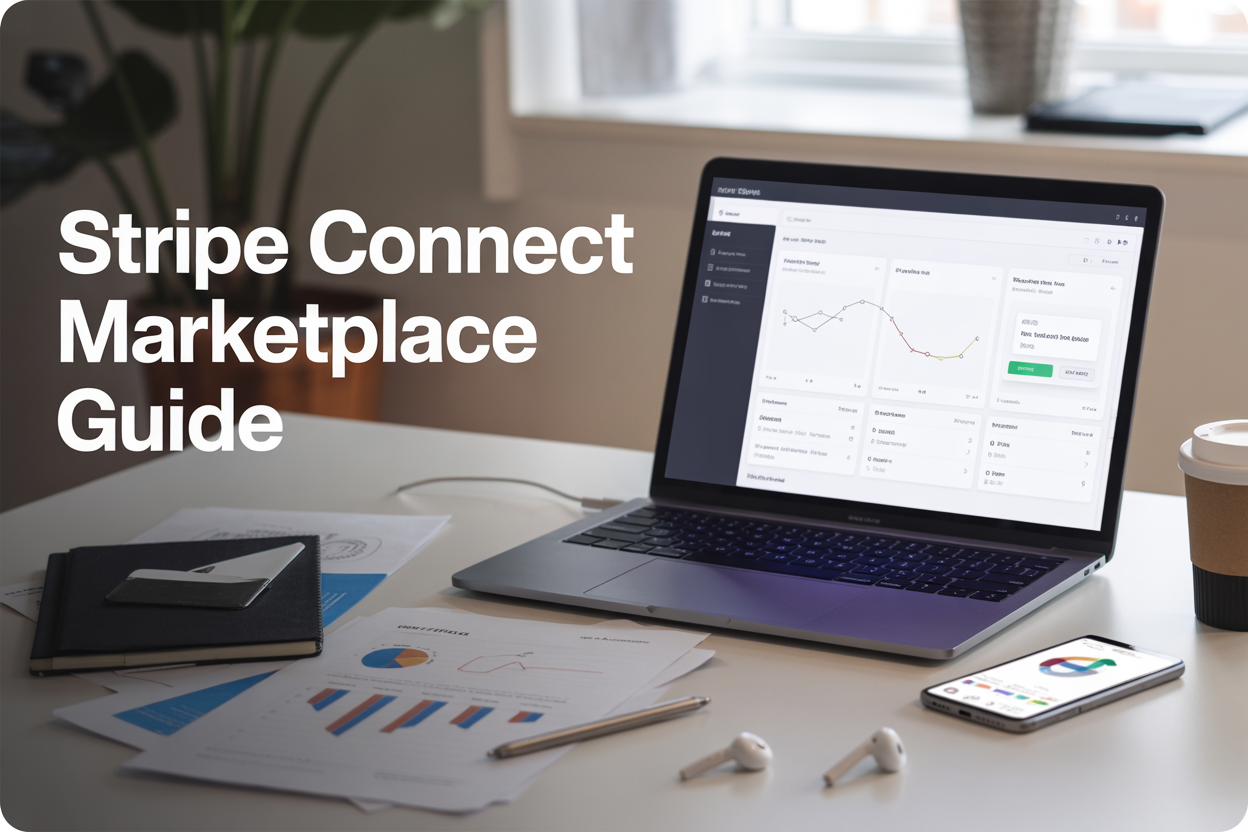Building a Powerful Marketplace with Stripe Connect: The Complete Guide
Creating a successful online marketplace means getting payments right from day one. Stripe Connect marketplace solutions handle the complex world of multi-party payments, letting you focus on growing your platform instead of wrestling with payment infrastructure.
This guide is for marketplace founders, developers, and product managers who want to build or improve their platform’s payment system. If you’re launching a new marketplace or upgrading from a basic payment setup, you’ll find practical steps to implement robust payment flows.
We’ll walk through Stripe Connect integration from the ground up, covering everything from initial setup to advanced features. You’ll learn how to streamline user onboarding and verification to get sellers up and running quickly while meeting compliance requirements. We’ll also dive deep into mastering payment flows and transaction management so you can handle complex scenarios like split payments, refunds, and dispute resolution with confidence.
By the end, you’ll have a clear roadmap for building marketplace payment processing that scales with your business and keeps both buyers and sellers happy.
Understanding Stripe Connect for Marketplace Success

Core functionality and payment flow mechanics
Stripe Connect marketplace payment processing works as a sophisticated system that automatically handles the complexities of multi-party transactions. When a buyer makes a purchase on your marketplace, the payment flows through your platform account before being distributed to the appropriate sellers, with your platform fee deducted along the way.
The payment flow begins when a customer initiates a transaction. Stripe Connect captures the full payment amount in your platform’s Stripe account, then automatically splits the funds according to your predetermined rules. This happens behind the scenes, creating a seamless experience for both buyers and sellers while giving you complete control over the transaction lifecycle.
Three distinct account types power this system: Standard, Express, and Custom accounts. Standard accounts give sellers the most autonomy – they create their own Stripe accounts and connect them to your platform. Express accounts offer a middle ground, where Stripe handles most of the complexity while sellers maintain some control over their payment settings. Custom accounts provide maximum platform control, where your marketplace manages nearly every aspect of the payment experience on behalf of sellers.
The payment mechanics also include sophisticated routing capabilities. You can split a single payment across multiple sellers, add application fees, handle refunds and disputes, and manage complex scenarios like subscription billing across multiple parties. This flexibility makes Stripe Connect suitable for everything from simple commission-based marketplaces to complex B2B platforms with intricate payment requirements.
Key advantages over traditional payment processing
Building marketplace with Stripe Connect offers significant advantages over cobbling together separate payment solutions. Traditional approaches often require sellers to have their own merchant accounts, creating friction in the onboarding process and fragmenting the payment experience across your platform.
The most compelling advantage is the unified payment experience. Instead of redirecting customers to external payment pages or requiring separate checkout processes for each seller, Stripe Connect keeps everything within your marketplace ecosystem. This reduces cart abandonment rates and maintains your brand consistency throughout the entire transaction.
Compliance becomes dramatically simpler with Stripe Connect integration. Rather than each seller needing to meet PCI compliance requirements individually, your marketplace benefits from Stripe’s enterprise-level security infrastructure. This removes a major barrier for smaller sellers who might otherwise struggle with compliance costs and complexity.
The platform also handles the intricate web of regulations around marketplace transactions. Know Your Customer (KYC) requirements, anti-money laundering (AML) checks, and tax reporting obligations are managed automatically based on transaction volumes and jurisdictions. This regulatory heavy lifting would be expensive and time-consuming to implement independently.
Revenue optimization becomes more sophisticated with built-in analytics and reporting. You get detailed insights into transaction patterns, seller performance, and fee optimization opportunities that would require significant development resources to create from scratch. The data flows seamlessly into your existing business intelligence systems, providing actionable insights for growth.
Supported business models and use cases
Stripe Connect marketplace platform supports an impressive range of business models, from straightforward commission-based platforms to complex multi-sided marketplaces. E-commerce marketplaces like Etsy-style platforms work perfectly, where individual sellers list products and you collect a percentage of each sale.
Service marketplaces thrive on Stripe Connect’s flexible payment timing. Whether you’re building a platform for freelancers, consultants, or local service providers, you can hold funds in escrow until work completion, release payments based on milestones, or handle subscription-based service relationships.
The platform excels at handling crowdfunding and donation platforms where funds need to be collected from multiple contributors and distributed according to campaign success metrics. The ability to hold funds and release them conditionally makes these complex scenarios manageable.
Software marketplaces and SaaS reseller platforms benefit from Stripe Connect’s subscription billing capabilities. You can manage recurring payments for multiple software vendors while collecting your platform fees, handling upgrades and downgrades, and managing complex billing cycles.
Multi-vendor subscription boxes, online education platforms with multiple instructors, and even complex B2B marketplaces with net payment terms all find success with Stripe Connect’s adaptable architecture.
Platform fees and revenue optimization strategies
Revenue optimization through marketplace payment processing requires strategic thinking about fee structures and timing. Stripe Connect supports multiple fee models that can be combined for maximum flexibility and profitability.
Application fees represent the most straightforward approach – you collect a fixed amount or percentage from each transaction. These fees can be charged to buyers, sellers, or split between both parties depending on your market positioning and competitive landscape.
Account debits offer more sophisticated revenue collection, allowing you to charge sellers for additional services like promoted listings, analytics packages, or premium seller tools. This creates multiple revenue streams beyond basic transaction processing.
The timing of fee collection impacts cash flow significantly. You can collect fees immediately when payments are processed, or defer them until funds are transferred to sellers. Some platforms use a hybrid approach, collecting a portion immediately for operational expenses and the remainder upon transfer.
Dynamic fee structures based on seller performance, transaction volume, or customer segments can maximize revenue while incentivizing desired behaviors. High-performing sellers might pay lower fees, while premium features command higher rates.
Consider implementing tiered fee structures that reward loyalty and growth. Sellers who consistently generate high volumes might graduate to lower fee tiers, while new sellers start at higher rates until they prove their value to your marketplace ecosystem.
Revenue optimization also includes minimizing payment processing costs through smart routing and payment method optimization. Encouraging lower-cost payment methods through targeted incentives can improve your margins while maintaining competitive seller fees.
Setting Up Your Stripe Connect Integration

Choosing the Right Connect Account Type for Your Needs
When building your Stripe Connect marketplace, the first critical decision involves selecting the appropriate account type. Stripe offers three distinct options, each designed for different marketplace models and business requirements.
Express accounts serve as the sweet spot for most marketplace platforms. Your sellers get a streamlined onboarding experience with minimal friction, while you maintain control over the user experience. Express accounts work perfectly when you want to brand the payment flow as part of your platform while keeping setup simple for your vendors. The onboarding typically takes just a few minutes, and Stripe handles most compliance requirements automatically.
Standard accounts give your sellers complete independence over their Stripe dashboard and payment settings. This option works best for marketplaces where vendors need full control over their payment operations or when you’re working with established businesses that already have existing Stripe accounts. The trade-off involves less control over the user experience and potentially more complex onboarding flows.
Custom accounts offer the highest level of control and customization. You manage the entire payment experience, from onboarding to transaction processing. This approach requires significant development resources and compliance expertise but delivers the most seamless branded experience for your users.
| Account Type | Setup Complexity | Control Level | Best For |
|---|---|---|---|
| Express | Low | Medium | Most marketplaces |
| Standard | Medium | Low | Independent sellers |
| Custom | High | High | Enterprise platforms |
Essential API Configurations and Webhook Setup
Proper Stripe Connect integration begins with configuring your API keys and webhook endpoints. Start by setting up separate API keys for your test and live environments. Your platform needs both publishable and secret keys, plus additional Connect-specific permissions.
The OAuth flow configuration enables sellers to connect their accounts seamlessly. Set up your redirect URIs in the Stripe dashboard, ensuring they match your application’s callback endpoints. The OAuth process should feel natural and secure for your users, with clear explanations of what permissions you’re requesting.
Webhook configuration forms the backbone of reliable marketplace payment processing. Essential webhook events include:
account.updated– Monitor changes to connected accountspayment_intent.succeeded– Track successful paymentstransfer.created– Log fund transfers to sellersaccount.application.deauthorized– Handle account disconnections
Configure webhook signing to verify event authenticity and prevent tampering. Your webhook endpoints should handle duplicate events gracefully and respond quickly to avoid retries. Implement proper error handling and logging to track webhook delivery issues.
API rate limiting considerations become crucial as your marketplace scales. Implement exponential backoff for failed requests and consider using Stripe’s idempotency keys for critical operations. This prevents duplicate charges during network issues or user errors.
Compliance Requirements and Legal Considerations
Marketplace transaction management involves navigating complex regulatory requirements. Know Your Customer (KYC) verification helps protect your platform from fraud while meeting legal obligations. Express accounts handle most KYC requirements automatically, but understanding the process helps you set proper user expectations.
Anti-Money Laundering (AML) compliance requires ongoing monitoring of transaction patterns. Stripe provides tools to flag suspicious activity, but your platform should implement additional safeguards. Set reasonable transaction limits for new accounts and monitor for unusual payment patterns.
Tax reporting obligations vary by jurisdiction, but marketplaces typically need to collect and report transaction data. Form 1099-K reporting in the United States requires tracking payment volumes for each seller. Plan your data collection strategy early to avoid compliance headaches later.
International expansion brings additional complexity with region-specific regulations like PCI DSS compliance, GDPR requirements, and local banking regulations. Research target markets thoroughly and consider partnering with legal experts familiar with payment regulations.
Consider implementing clear terms of service that outline fee structures, dispute resolution processes, and account termination procedures. Transparent communication about fees and policies reduces conflicts and builds trust with your marketplace participants.
Document retention policies ensure you maintain necessary records for audits and dispute resolution. Store transaction data, identity verification documents, and communication logs according to regulatory requirements in your operating jurisdictions.
Streamlining User Onboarding and Verification

Creating seamless seller registration experiences
The first impression matters when bringing new sellers onto your Stripe Connect marketplace. A smooth registration process can make the difference between attracting top-quality vendors and losing them to competitors before they even start selling.
Start by designing a progressive onboarding flow that breaks complex information gathering into digestible steps. Instead of overwhelming sellers with a single massive form, create a wizard-style interface that guides them through basic business information first, then payment details, and finally verification documents. This approach reduces abandonment rates significantly.
Implement Stripe’s Express accounts for most sellers, as they provide the fastest path to accepting payments while maintaining compliance. Express accounts handle the heavy lifting of regulatory requirements while giving you control over the user experience. For sellers who need more customization or want direct relationships with Stripe, Custom accounts offer greater flexibility at the cost of additional compliance responsibilities.
Pre-populate forms wherever possible using business databases or social media APIs. When a seller enters their business name or tax ID, automatically fetch and fill relevant information like business address, industry type, and contact details. This reduces friction and demonstrates professionalism.
Create mobile-optimized registration flows since many sellers will sign up using their phones. Touch-friendly interfaces, camera integration for document uploads, and simplified navigation become critical for capturing sellers who discover your platform on the go.
Consider offering multiple registration paths based on seller types. A handmade jewelry creator has different needs than a B2B software vendor. Tailored onboarding experiences show you understand their business and can increase conversion rates by 40% or more.
Automated identity verification and KYC processes
Stripe Connect integration includes robust identity verification capabilities that automate much of the KYC (Know Your Customer) process. Smart automation reduces manual review time while maintaining compliance with financial regulations across different jurisdictions.
Stripe automatically verifies seller identities using government databases, credit bureaus, and other trusted sources. The system checks names, addresses, dates of birth, and tax identification numbers against official records. Most legitimate sellers pass this initial screening within minutes, enabling them to start selling immediately.
Set up webhook listeners to handle verification status updates in real-time. When Stripe completes identity checks, your system should automatically update seller status, send notification emails, and trigger next steps in your onboarding flow. This creates a seamless experience without manual intervention.
For sellers who don’t pass automated verification, implement a structured manual review process. Create admin dashboards where your team can review submitted documents, cross-reference information, and make approval decisions. Stripe provides detailed reasons for verification failures, helping your team focus on specific issues.
Build intelligence into your verification system by tracking common rejection patterns. If sellers from certain industries or regions frequently fail automated checks for specific reasons, you can proactively guide them to submit additional documentation or clarify requirements upfront.
Managing international sellers and tax compliance
Expanding globally brings complexity in seller verification and tax compliance, but Stripe marketplace platform capabilities simplify much of this challenge. Different countries have varying requirements for business registration, tax collection, and financial reporting.
Stripe Connect supports sellers from over 40 countries, each with specific verification requirements. European sellers might need to provide VAT numbers, while US sellers require EIN or SSN verification. The platform automatically applies appropriate verification steps based on the seller’s location.
Implement dynamic tax collection based on seller and buyer locations. Stripe Tax can automatically calculate, collect, and remit taxes for marketplace transactions, reducing your compliance burden while ensuring sellers meet their obligations. This becomes particularly valuable when dealing with complex scenarios like digital goods across EU boundaries or sales tax nexus in multiple US states.
Create country-specific onboarding guides and FAQs addressing local requirements. Sellers appreciate clear guidance about documentation needs, tax obligations, and payout timelines specific to their jurisdiction. This proactive support reduces support tickets and accelerates approval times.
Handling rejected applications and account restrictions
Not every seller application will succeed, and marketplace payment processing regulations require strict adherence to risk management protocols. How you handle rejections and restrictions can significantly impact your platform’s reputation and seller relationships.
Design clear communication workflows for different rejection scenarios. Sellers deserve to understand why their applications failed and what steps they can take to resolve issues. Create templated responses for common rejection reasons while allowing for personalized explanations when needed.
Implement an appeals process for sellers who believe they were incorrectly rejected. Sometimes legitimate businesses get flagged due to name similarities with restricted entities or temporary issues with verification databases. A structured appeals process demonstrates fairness and can recover potentially valuable sellers.
Monitor for patterns in rejections that might indicate problems with your onboarding process. If legitimate sellers frequently fail at specific verification steps, you might need to adjust requirements, improve documentation guidance, or work with Stripe to refine verification parameters.
Set up graduated restrictions rather than binary approval/rejection decisions where possible. Sellers with minor verification issues might receive temporary limits on transaction volumes or payout frequencies while they resolve documentation problems. This approach maintains revenue flow while managing risk appropriately.
Mastering Payment Flows and Transaction Management

Direct Charges vs Destination Charges Implementation
When building your Stripe Connect marketplace, choosing between direct charges and destination charges shapes your entire payment architecture. Direct charges give you complete control over transactions – your platform account holds the funds first, then distributes payments to connected accounts. This approach works best when you need tight control over refunds, disputes, or complex fee calculations.
Destination charges flip this model. Payments go directly to your sellers’ accounts, with your marketplace fee automatically deducted. This creates a cleaner separation of funds and reduces your compliance burden since you’re not holding customer money.
Here’s how each model impacts your marketplace operations:
| Feature | Direct Charges | Destination Charges |
|---|---|---|
| Fund Control | Platform holds funds | Seller receives funds directly |
| Refund Management | Platform initiates refunds | Requires coordination with seller |
| Dispute Handling | Platform manages disputes | Seller handles disputes directly |
| Fee Flexibility | Full control over timing/calculation | Limited to application fees |
Split Payment Configurations for Complex Fee Structures
Marketplace payment processing often involves intricate fee structures that go beyond simple percentage cuts. Stripe Connect handles multi-layered fee distributions through application fees, transfers, and account debits.
Start with application fees for straightforward scenarios – automatically deduct your marketplace commission during payment processing. For more complex structures, combine application fees with transfers to create sophisticated profit-sharing models.
Consider a scenario where you need to:
- Take a 3% marketplace commission
- Allocate 1% to a referral partner
- Send 0.5% to a charity program
- Pay the remaining 95.5% to the seller
You can automate this entire flow using Stripe’s transfer API immediately after charge completion. Set up webhooks to trigger these transfers based on your business rules, ensuring consistent fee distribution across all transactions.
Refund Handling and Dispute Management Automation
Automated refund processing prevents customer service headaches while maintaining seller relationships. Create refund policies that automatically trigger based on predefined conditions – failed deliveries, cancellations within specific timeframes, or quality issues.
For marketplace transaction management, implement tiered refund logic:
- Instant refunds: Product not shipped within 24 hours
- Partial refunds: Late deliveries or minor quality issues
- Manual review: High-value transactions or repeat refund requests
Dispute management requires proactive monitoring. Set up automated responses for common dispute reasons while flagging complex cases for manual review. Track dispute rates by seller to identify patterns and prevent future issues.
Multi-Party Transaction Coordination
Complex marketplace transactions often involve multiple parties beyond buyers and sellers. Think affiliate commissions, service provider fees, or shared revenue models. Stripe Connect’s transfer system handles these scenarios through conditional transfers and account hierarchies.
Create transaction workflows that automatically distribute payments based on completion milestones. For service marketplaces, release funds to providers only after customer confirmation. For product marketplaces, trigger affiliate payments when items ship successfully.
Currency Conversion and International Payment Optimization
International Stripe Connect marketplace operations require careful currency handling to minimize conversion costs and maximize seller satisfaction. Stripe automatically handles currency conversion, but smart marketplace design can reduce fees and improve user experience.
Implement local pricing strategies where sellers set prices in their local currency while buyers pay in theirs. This approach reduces conversion friction while letting Stripe handle the complexity behind the scenes.
Set up currency-specific accounts for high-volume international sellers. This allows them to collect payments in multiple currencies without constant conversion fees, improving their profit margins and encouraging platform loyalty.
Monitor conversion rates and fees across different currency pairs. Some combinations offer better rates than others, and you can guide sellers toward optimal pricing strategies that benefit both parties.
Advanced Features for Marketplace Growth

Instant payouts and flexible payout scheduling
Speed matters in marketplace operations. When sellers receive their money quickly, they stay engaged and trust your platform. Stripe Connect’s instant payouts feature transforms the traditional waiting period from days to minutes, giving your marketplace a competitive edge that keeps merchants happy.
Setting up instant payouts requires enabling the feature in your Connect dashboard and ensuring your sellers have eligible debit cards. The process works through real-time bank transfers, typically completing within 30 minutes. Your sellers can request payouts manually through their dashboard, or you can automate the process based on specific triggers like completed orders or daily thresholds.
Flexible payout scheduling gives you control over when and how money flows through your marketplace. You can configure automatic payouts on daily, weekly, or monthly schedules, or let sellers choose their preferred timing. This flexibility proves especially valuable for different seller types – some prefer immediate access to funds, while others benefit from batched payouts for easier accounting.
The technical implementation involves using Stripe’s Transfer API with the instant parameter. Here’s what your payout logic might look like:
| Payout Type | Processing Time | Availability | Best For |
|---|---|---|---|
| Standard | 2-7 business days | All accounts | Regular operations |
| Express | Next business day | Most accounts | Improved satisfaction |
| Instant | 30 minutes | Debit cards only | Urgent needs |
Managing payout costs becomes important as your marketplace scales. Instant payouts typically cost more than standard transfers, so consider offering them as a premium feature or absorbing costs for high-value sellers.
Escrow services and payment holds implementation
Escrow functionality builds trust between buyers and sellers by holding funds until transaction conditions are met. This feature proves essential for high-value transactions, custom orders, or services delivered over time. Your Stripe Connect marketplace can implement escrow through payment holds and conditional transfers.
Payment holds work by capturing funds from buyers but delaying the transfer to sellers until specific conditions are satisfied. You control the release mechanism through your platform logic – whether that’s delivery confirmation, buyer approval, or a predetermined time period. This approach protects both parties while maintaining cash flow predictability.
Building escrow services starts with capturing payments using Stripe’s Payment Intents API with the capture_method set to manual. You then create the payment but don’t immediately transfer funds to the seller’s connected account. Instead, you hold the money in your platform account until release conditions are met.
Common escrow scenarios include:
- Service marketplaces: Hold payment until project completion and buyer approval
- Physical goods: Release funds after delivery confirmation or return period expires
- Booking platforms: Partial holds for deposits, full release after service completion
- Custom manufacturing: Milestone-based releases throughout production process
The implementation requires careful state management. Your system needs to track payment status, escrow conditions, and release triggers. Consider building automated release mechanisms for standard scenarios while maintaining manual override capabilities for disputes.
Risk management becomes critical with escrow services. You’re essentially providing financial guarantees, so establish clear policies for dispute resolution, maximum hold periods, and automated release timelines to avoid indefinite fund holds.
Subscription and recurring billing for marketplace services
Recurring revenue transforms marketplace dynamics by creating predictable income streams for both your platform and connected sellers. Stripe Connect’s subscription capabilities enable complex billing scenarios where multiple parties receive recurring payments from the same customer subscription.
Marketplace subscriptions differ from traditional SaaS billing because money flows to multiple recipients. A customer might subscribe to a service where the seller receives most of the payment, your platform takes a commission, and third-party services get their share. Stripe Connect handles this complexity through application fees and transfers.
Setting up marketplace subscriptions involves creating subscription products for sellers while configuring automatic application fee collection. Your platform can offer subscription management tools to sellers, including pricing flexibility, trial periods, and upgrade paths. The key advantage is maintaining a single billing relationship with customers while distributing payments appropriately.
Implementation approaches vary based on your marketplace model:
Seller-managed subscriptions: Sellers create their own subscription products with your platform collecting fees through application_fee_percent. This works well for independent service providers or content creators.
Platform-managed subscriptions: Your marketplace creates and manages all subscription products, giving you more control over pricing and billing cycles. Payments are then distributed to sellers through transfers.
Hybrid models: Combine both approaches, letting some sellers manage their subscriptions while providing managed options for others.
Technical considerations include handling subscription lifecycle events like upgrades, downgrades, and cancellations. Your webhook handlers need to process these changes and update seller payouts accordingly. Failed payments require careful handling to maintain service continuity while managing payment recovery.
Subscription analytics become valuable for marketplace growth. Track metrics like monthly recurring revenue (MRR), churn rates, and average revenue per user (ARPU) both at the platform level and for individual sellers. This data helps identify successful subscription strategies and guides marketplace development priorities.
Security Best Practices and Risk Management

PCI Compliance and Data Protection Strategies
Building a secure Stripe Connect marketplace starts with understanding that Stripe handles most PCI compliance requirements for you. When you process payments through Stripe, they take on the burden of maintaining PCI DSS Level 1 certification, which means your marketplace automatically inherits these security standards without needing to undergo complex compliance audits yourself.
Your responsibility shifts to implementing proper data handling practices on your platform. Never store sensitive payment information like full credit card numbers, CVV codes, or bank account details in your own databases. Instead, use Stripe’s tokenization system to store secure references to payment methods. This approach dramatically reduces your PCI scope and eliminates the risk of exposing sensitive financial data.
Implement strong data encryption for all user information stored in your systems. Use industry-standard encryption protocols like AES-256 for data at rest and TLS 1.3 for data in transit. Regular security audits and penetration testing help identify potential vulnerabilities before they become actual threats.
Consider implementing data retention policies that automatically purge unnecessary sensitive information after specific periods. This reduces your attack surface and demonstrates good data stewardship to your users and regulatory bodies.
Fraud Prevention and Monitoring Systems
Stripe Connect integration provides built-in fraud detection through Stripe Radar, which uses machine learning to identify suspicious transactions. However, marketplace-specific fraud patterns require additional layers of protection tailored to your platform’s unique characteristics.
Implement velocity checks that monitor unusual patterns in user behavior. Watch for accounts that suddenly increase transaction volumes, create multiple seller profiles, or attempt rapid-fire small transactions that could indicate card testing. Set up automated alerts when users exceed predefined transaction thresholds within specific time windows.
Create robust identity verification workflows for both buyers and sellers. Require multiple forms of identification for high-value transactions and implement gradual trust-building systems that increase transaction limits as users demonstrate legitimate activity over time.
Monitor for marketplace-specific fraud indicators like sellers who consistently receive chargebacks, buyers who frequently dispute transactions, or accounts that show signs of coordinated activity. Cross-reference IP addresses, device fingerprints, and behavioral patterns to identify potential fraud rings before they cause significant damage.
Account Security and Access Control Implementation
Multi-factor authentication should be mandatory for all marketplace participants, especially sellers who handle financial transactions. Implement time-based one-time passwords (TOTP) or SMS verification as minimum requirements, with hardware security keys available for high-volume merchants.
Design role-based access control systems that limit what different user types can access within your platform. Sellers should only see their own transaction data and payout information, while administrators need carefully scoped permissions that follow the principle of least privilege.
Create secure session management that automatically logs out inactive users and implements proper token rotation. Use secure, httpOnly cookies for session storage and implement proper CSRF protection across all forms and API endpoints.
Regular security training for your team members helps prevent social engineering attacks and ensures everyone understands their role in maintaining platform security. Create clear procedures for handling suspicious account activity and establish communication channels for reporting potential security incidents.
Backup Payment Methods and Failover Systems
Diversifying your payment processing infrastructure protects your marketplace from single points of failure. While Stripe Connect serves as your primary payment processor, maintaining relationships with backup processors ensures business continuity during service disruptions or account issues.
Implement automatic retry logic for failed payments that attempts transactions through alternative methods when the primary processor is unavailable. This system should be intelligent enough to route transactions based on failure reasons, geographic restrictions, or processor-specific limitations.
Store multiple payment methods for users when possible, allowing them to seamlessly switch between cards or bank accounts if their primary method fails. This reduces transaction abandonment rates and improves overall user experience while providing backup options during payment processing issues.
Create comprehensive monitoring systems that track payment success rates across different processors and automatically switch traffic when performance degrades below acceptable thresholds. Document clear escalation procedures for your team to follow during payment processing emergencies.
Regular testing of failover systems ensures they work correctly when needed most. Schedule quarterly drills that simulate various failure scenarios and verify that your backup systems can handle your platform’s transaction volume without degrading user experience.
Monitoring Performance and Scaling Your Platform

Analytics Integration and Revenue Tracking
Building robust analytics into your Stripe Connect marketplace platform starts with understanding the data flowing through your system. Stripe provides comprehensive reporting tools through their Dashboard API, but smart marketplace operators create custom analytics solutions that capture the unique metrics their business needs.
The most successful Stripe Connect marketplace platforms track both financial and operational metrics. Revenue tracking goes beyond simple transaction volumes – you need to monitor gross merchandise value (GMV), take rates, refund patterns, and seller performance trends. Create custom dashboards that show real-time revenue splits between your platform fees and seller payouts.
Your analytics stack should include:
- Transaction-level tracking: Monitor every payment, transfer, and fee with detailed metadata
- Seller performance metrics: Track individual seller revenue, dispute rates, and customer satisfaction
- Platform health indicators: Monitor payment success rates, average transaction times, and API response times
- Revenue forecasting: Use historical data to predict future growth and identify seasonal patterns
Popular analytics tools like Mixpanel, Amplitude, or Google Analytics can integrate seamlessly with Stripe’s webhooks. Set up automated reports that trigger when key metrics hit certain thresholds – like when daily GMV exceeds your targets or when dispute rates climb above acceptable levels.
Performance Optimization for High-Volume Transactions
As your marketplace payment processing scales beyond thousands of daily transactions, performance becomes critical. The difference between a marketplace that handles peak traffic gracefully and one that crashes during high-demand periods often comes down to architectural decisions made early in development.
Database optimization forms the foundation of high-performance marketplaces. Index your most frequently queried fields – particularly transaction IDs, seller IDs, and timestamp columns. Consider implementing read replicas for analytics queries that don’t require real-time data. This prevents heavy reporting queries from slowing down your live transaction processing.
Implement these performance strategies:
| Strategy | Impact | Implementation Difficulty |
|---|---|---|
| API request batching | Reduces API calls by 70-80% | Medium |
| Webhook queue processing | Prevents webhook timeouts | High |
| Database connection pooling | Improves response times by 40% | Low |
| CDN for static assets | Faster page loads globally | Low |
| Redis caching layer | Reduces database queries by 60% | Medium |
Stripe Connect’s webhooks can overwhelm your system during traffic spikes. Build a robust queue system using tools like Redis, Amazon SQS, or Google Cloud Tasks. Process webhooks asynchronously – acknowledge receipt immediately, then handle the business logic separately. This prevents Stripe from marking your webhooks as failed during temporary slowdowns.
Consider implementing circuit breakers for external API calls. When Stripe experiences downtime or slow responses, your circuit breaker can temporarily disable non-critical features while keeping core functionality running.
Troubleshooting Common Integration Issues
Even well-built Stripe Connect integration systems face predictable challenges. The most common issues stem from webhook handling, account verification problems, and payout failures.
Webhook failures top the list of support tickets for most marketplaces. Stripe requires webhook endpoints to respond within 10 seconds with a 2xx status code. Build robust error handling that logs failed webhook attempts with full context. Create monitoring alerts when webhook success rates drop below 95%.
Common webhook debugging steps:
- Verify endpoint accessibility: Test your webhook URL from external networks
- Check response times: Log processing times for each webhook type
- Validate signatures: Always verify webhook signatures to prevent spoofed requests
- Handle duplicate events: Implement idempotency keys to prevent double-processing
Account verification issues frustrate both sellers and marketplace operators. Stripe’s identity verification requirements vary by country and can change without notice. Build a comprehensive onboarding flow that clearly explains required documents and provides real-time feedback on submission status.
Create automated monitoring for common failure patterns:
- Payment methods that consistently fail across multiple transactions
- Sellers experiencing unusual payout delays
- Customers reporting charges they don’t recognize
- API error rate spikes during specific time periods
Planning for Marketplace Expansion and Growth
Successful Stripe marketplace platform expansion requires careful planning around both technical infrastructure and business operations. Start by analyzing your current transaction patterns to predict future load requirements.
Geographic expansion presents unique challenges. Stripe Connect operates differently across countries – some regions require local bank accounts for payouts, others have different identity verification requirements. Research target markets thoroughly before expanding, paying special attention to local payment methods and regulatory requirements.
Technical scaling considerations include:
- Multi-region deployment: Reduce latency by hosting closer to your users
- Database sharding: Distribute transaction data across multiple databases
- Microservices architecture: Break apart monolithic systems for better scalability
- API rate limit management: Implement intelligent retry logic and request throttling
Plan your feature roadmap around marketplace maturity. Early-stage platforms focus on basic payment processing and seller onboarding. Growth-stage marketplaces need sophisticated analytics, advanced seller tools, and fraud prevention systems. Mature platforms require internationalization, complex fee structures, and enterprise-grade reporting.
Consider implementing feature flags for gradual rollouts. Test new payment flows with small user segments before full deployment. This approach minimizes risk while allowing rapid iteration based on user feedback.
Build relationships with Stripe’s support team early. Enterprise accounts receive dedicated support that becomes invaluable during scaling challenges. Regular check-ins with your Stripe account manager can provide early warnings about policy changes or new features that might benefit your platform.

Stripe Connect offers marketplace builders everything they need to create a thriving platform that handles payments seamlessly. From the initial setup and user onboarding to advanced features like split payments and automated transfers, this payment solution removes the technical headaches that often bog down marketplace development. The built-in security measures and compliance tools mean you can focus on growing your business instead of worrying about regulatory requirements or fraud prevention.
Success with Stripe Connect comes down to getting the basics right first, then gradually adding sophisticated features as your marketplace grows. Start with a solid integration, make onboarding as smooth as possible for your users, and always keep security at the forefront of your planning. With the right approach to monitoring and scaling, your marketplace can handle everything from a few dozen transactions to millions of payments without missing a beat. The tools are there – now it’s time to build something amazing.




















